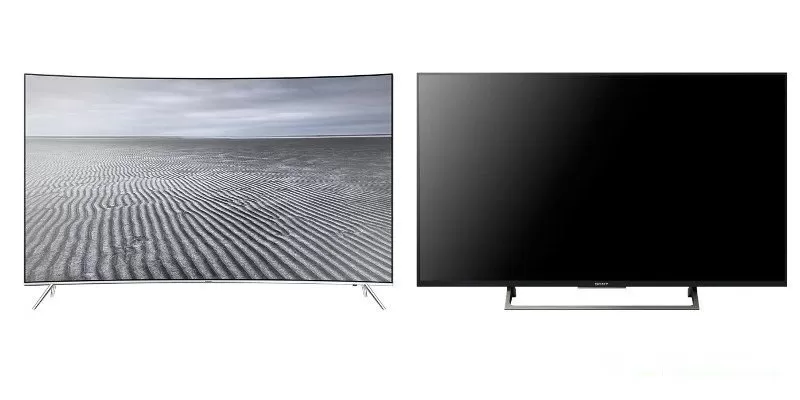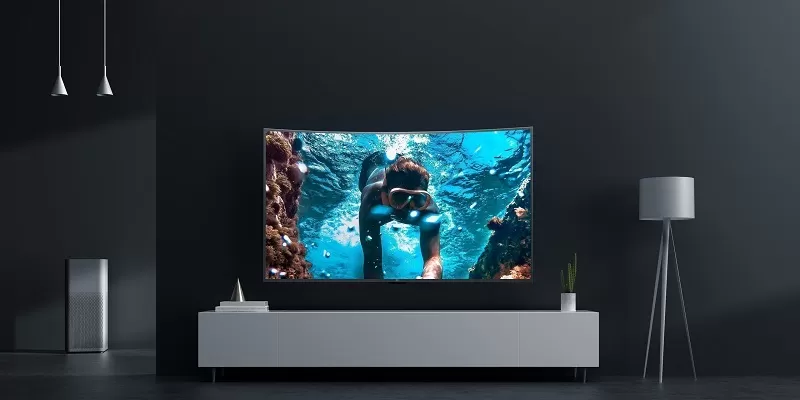
Which TV screen is better — curved or flat?
Starting around 2014-2015, more and more video equipment manufacturers are releasing curved TVs. And this is not just a way to slightly increase the price of equipment. Curved screens — slightly concave, as opposed to convex «Cinescopes» — provide a whole new visual experience.
We will figure out whether it is worth overpaying for cinematography and which TV screen is better — curved or flat.
Comparison of curved and flat screen TVs

We will compare curved and flat screens according to the following parameters:
-
Immersion effect;
-
Contrast and viewing angles;
-
Number of reflections;
-
Visual area of the screen;
-
The amount of optical distortion.
Actually, it is these parameters that are indicated by sellers and manufacturers of curved TVs as key ones. Therefore, we will consider them.
Immersion effect
Most often, curved screen TVs are compared to IMAX. Say, both there and there the display is concave, the “picture” seems to be from all sides and the viewer seems to be in the film. This is true, but only in part.
The optical laws that work on a 22×16 meter canvas don’t work very well on a 55-inch matrix. That is, there is an immersion effect, yes. But for this you need to sit right in front of the TV at a distance of up to 1.5-2 meters. Moreover, if you sit down from the display by 2-3 meters — this is the place recommended by doctors for viewing — then visually all this curvature will disappear, and the TV screen will seem flat.
However, the effect of immersion still manifests itself — if you take a curved TV with a diagonal larger than 55 inches. For example, 65-inch displays retain their radius of curvature if you sit 2.5-3 meters away from them. There are not very many such models, but they are in the lines of Haier, Samsung, and other manufacturers.
Thus, concave TV screens retain their immersive effect in two ways:
-
If you sit close enough to them (1.5-2 meters);
-
If they are large enough (60-65 inches).
In other cases, there is little point in overpaying — unless, of course, you use them as a monitor.
Contrast enhancement
The second advantage of curved TVs over «smooth» ones, according to manufacturers, is an increase in contrast at the edges of the image. And, surprisingly, it’s completely true. LCD matrices do lose image contrast at the edges — and with a light field from a concave display, they are quite capable of restoring it.
However, this effect is noticeable only if you sit directly in front of the TV screen. As well as the very notorious «immersion effect». It is worth sitting down a little to the side — as the loss of contrast, on the contrary, increases many times over.
And being right in front of the screen in the conditions of a large family is a “problem with an asterisk”. Therefore, it is better to buy such a TV for 1-2 viewers.
Viewing angles

But this feature of concave matrices is usually not advertised by television equipment manufacturers, because this is the main drawback of a curved display. What does it consist of:
-
Flat screens, depending on the matrix production technology, have a viewing angle of 150-178 degrees horizontally. This means that they can be seen from any corner of the room;
-
Concave screens, in turn, physically do not reach the viewing angle of at least 150 degrees. In addition, the higher it is relative to the vertical center, the more the image is visually distorted.
Thus, a TV with a concave display must be placed so that the sofa from which it is planned to watch them is directly opposite.
Number of reflections
And now — the absolute advantage of curved matrices over «smooth» ones.
Flat matrices glare, and glare is very strong. They reflect any light source, be it the sun from a window, a lamp from the ceiling, or something white in the interior of the room. As a result, it even happens that it becomes impossible to watch TV or movies during the day — bright reflections from the window are reflected on the display and block the “picture”.
Curved matrices also seem to glare, but reflect light in a slightly different direction than flat ones. That is why, if you watch TV while sitting in front of it — well, or at a small angle from the center — there is no glare.
Thus, if you plan to install a TV in a bright room, with many windows or lamps, then it is better to take a concave one, with a standard curvature of 1800. Watching something from a flat display in such conditions will be one sheer “pleasure”.
Visual screen area
Another advantage that is really an advantage and not just a marketing gimmick. Curved screens, if you sit right in front of them, really seem to be more «straight» with the same diagonal.
The matrix seems larger due to the fact that the brain, accustomed to «direct» screens, «completes» the image. So, with an actual diagonal of 140 centimeters, a person who sits in front of him at a distance of 2-2.5 meters will feel him as 1.5 meters. The advantage is small, of course, but still the “wow effect” is observed.
In addition, the so-called «visual effective» area increases. With eye comfort, a person using a flat screen TV can only look at one point at a time, plus a relatively small field of view. The edges of the image literally fall out of it.
The concave matrix does not have this disadvantage. The field of view of a person sitting in front of such a TV screen is somewhat wider — and you can look at objects from different angles without straining your eyes.
Reduce optical distortion
It would seem that this is quite fair. Each dot on a flat display is located relative to the eye at an angle that increases with distance from the center. For curved matrices, the angle also increases, but not so much.
But! First, films are shot on a flat sensor. Secondly, the brain (as it is clear from the section above) itself completes the curved image to a flat one. And finally, when you try to look at the matrix at an angle — from the side, for example — the objects on it are «stretched».
As a result, the amount of optical distortion only increases.
Comparison table of flat and curved TVs
Thus, we can summarize the advantages and disadvantages of all these types of matrices into one large table:
|
|
|
|
|
Immersion effect
|
Only if the movie is so interesting that you forget about the TV hanging on the wall
|
Only if you sit right in front of the TV screen at a fairly short distance
|
|
edge contrast
|
Small, even for matrices with Direct LED
|
Thanks to the light field, it increases significantly
|
|
Viewing angles
|
Up to 178 degrees for IPS TVs
|
Up to 150 degrees, strong distortion when viewed from the side
|
|
Reflections and glare
|
Lots of
|
Hardly ever
|
|
visual area
|
Less actual
|
More actual
|
|
Optical distortion
|
May be colored when viewed from a high angle (side)
|
There are visual ones (will take some getting used to, then become invisible), and physical ones when viewed from an angle
|
When Should You Buy a Curved TV?
Buying a curved screen TV is worth it in the following cases:
-
It is planned to watch it from a close distance;
-
There are many luminous and glare objects in the room;
-
I want the largest possible TV;
-
It is planned to buy a small TV and use it as a monitor.
In other cases, it will be an excessive overpayment. And for viewing with a large family or with friends, it is not at all suitable. Not only will none of the viewers be at the so-called focal point (the ideal place for comfortable viewing), but also a very distorted image will be shown to people sitting on the edge.
Similarly, a concave TV screen is not the best solution for the kitchen. Kitchen TV devices are usually set somewhere on the refrigerator away from the table, at an angle to view the news during breakfast. It is difficult to imagine the level of discomfort when using a concave screen in such conditions.
On the other hand, manufacturers often make top models of their television devices concave. For example, Samsung in many models install QLED-matrix with pure spectral color and close to absolute black, which maintains excellent visibility when viewed from an angle. LG, in turn, uses an active OLED-matrix with absolute black and infinite contrast, which further enhances the image quality when viewed sideways.
So if you take a curved TV for viewing by a company, then QLED or OLED. They provide excellent image quality. And for independent use, any other is suitable.
Добавить комментарий
Для отправки комментария вам необходимо авторизоваться.